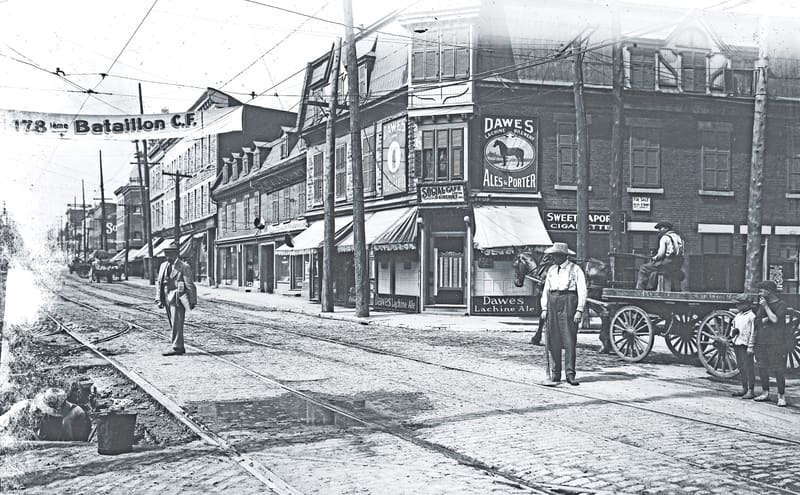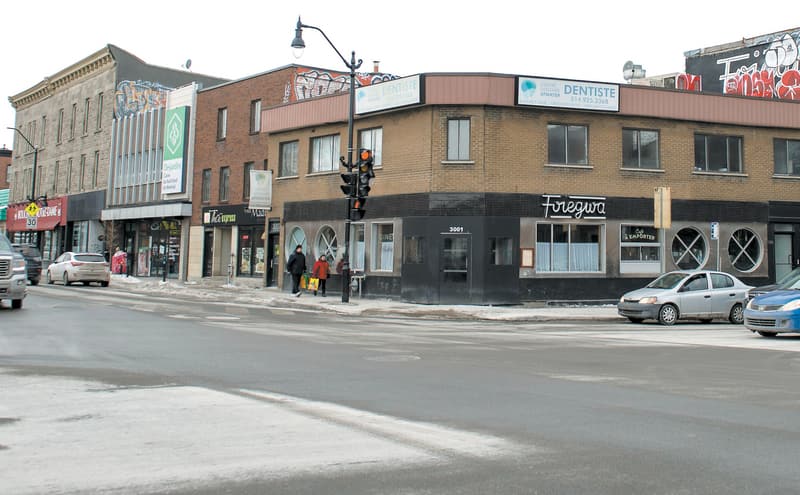A Saloon in Saint-Henri

 Photo courtesy, Archives of the City of Montreal, [Social Coffee, O. Gibeault, 476 av Atwater, corner Notre-Dame West, St. Henri], 1916. VM117-Y-1P0056. Photo Ben Pelosse
Photo courtesy, Archives of the City of Montreal, [Social Coffee, O. Gibeault, 476 av Atwater, corner Notre-Dame West, St. Henri], 1916. VM117-Y-1P0056. Photo Ben Pelosse
Centre d’histoire de Montréal
Saturday, 10 February, 2018 20:26
UPDATE
Saturday, 10 February, 2018 20:26
Look at this article
The Social Cafe of Mr. Gibeault
This scene of the 1916 seems to be drawn straight from a western film. Yet, it is the workers of the landfill to the intersection of Notre-Dame West and Atwater avenue, in Saint-Henri. The puddle of water on the pavement hints at a leak of the aqueduct. By this hot day, the men are worn a hat to protect you from the sun. There is everything to bet that they will go to drink at the end of the day at the Social Cafe of Mr. Oswald Gibeault. In 1916, Mr. Gibeault has two institutions, a first in Lachine, and a second in Saint-Henri. On the other side of the door worthy of a saloon of the Wild West, beer and full meals await guests in the dining room. At the counter, the cigarettes, Sweet Caporal are highlighted on the display. In these times of war when the threat of conscription flat, the Café of Mr. Gibeault provides a moment of respite to workers who are in need.
The beer Dawes and the war
On the walls, advertising for the new beer Black Horse brewery Dawes draws the eye. Yet, in these times of prohibition and war, it is not easy to be the owner of a brewery. According to the war measures act, the alcohol, as its place of manufacture, may be requisitioned to produce acetone, used for the manufacture of chemical gases. As the enemies of the fatherland, the Germans, are known to be of great brewers and beer drinkers, it is considered de facto as unpatriotic. This is why the Königsbier lager German brewed by Dawes, is quickly renamed the Kingsbeer in 1914. Prohibitionists are pleased to recall that alcohol affects the productivity of the workers and soldiers. The federal government prohibits finally the sale of alcohol in march 1918. This is maintained everywhere in Canada after the war, except in Quebec, which decided to control the production and the sale.
The 178th battalion French canadian
This banner indicates, without doubt, a military parade of the 178th, one of the 13 battalions, recruited in French Canada during the First world War. The deadly conflict dragged on at, the intensive recruitment of volunteers gives poor results in 1916, giving the impression that soon the compulsory enlistment. The recruitment posters of the 178th battalion reflect this tension : “do you Expect that we [churches] burn ? Enrôlons-we and immediately. “” The pure Canayens : Show that we are a race of proud and loyal. “” To want is power “, such is the motto of this battalion recruited in the areas of Drummond-Arthabaska and Montreal. Once arrived at Liverpool on march 15, 1917, the recruits in the 178th battalion, joining, among others, the royal 22e regiment (the ” Vandoos “, as pronounced in English), the only francophone unit in the canadian expeditionary force. The soldiers of the 178th stand at the battle of Amiens on 8 August 1918, the first victory that leads the Allies at the Armistice, 11 November 1918.



